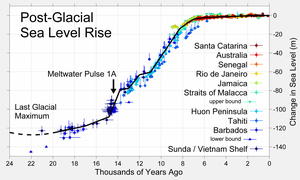 Image via Wikipedia
Image via Wikipedia
Eustasy is associated with land movement (subsidence, plate movement, seismic activity), thermal expansion, and the movement of water stored on land to the sea. The GFDL climate model estimates that at 2 times the current CO2 levels, the sea level rise in 100 years due solely to thermal expansion would be approximately 0.25 m (or 1.0 m in 500 years); at 4 times current CO2 levels, 0.3 m and 1.75 m, respectively ( see http://www.gfdl.noaa.gov/ ).
Here's a simple calculation of sea level rise from NASA intended for middle school earth sciences' students that estimates about 80 meters (problems include assuming all rise is vertical and ignoring glaciers outside of Antarctica and Greenland). See https://pumas.gsfc.nasa.gov/files/02_10_97_1.pdf .
According to Rowley, R. J., Kostelnick, J. C., Braaten, D., Li, X., & Meisel, J. (2007). Risk of rising sea level to population and land area. Eos, 88(9), 105–107, rising sea levels would inundate large areas and force major population migrations. For examples,
1 m rise - 1.05 million km2 flooded - 108 million population affected worldwide
2 m rise - 1.31 million km2 flooded - 175 million affected
3 m rise - 1.54 million km2 flooded - 234 million affected
4 m rise - 1.78 million km2 flooded - 308 million affected
5 m rise - 2.00 million km2 flooded - 376 million affected
6 m rise - 2.19 million km2 flooded - 431 million affected
For animations of sea level rise, see http://cegis.usgs.gov/sea_level_rise.html .
Integrated coastal zone management is an important consideration in dealing with the potential for sea rise.
![Reblog this post [with Zemanta]](http://img.zemanta.com/reblog_e.png?x-id=03b1c738-3887-4d32-b81e-d8eb6b8036ae)
No comments:
Post a Comment